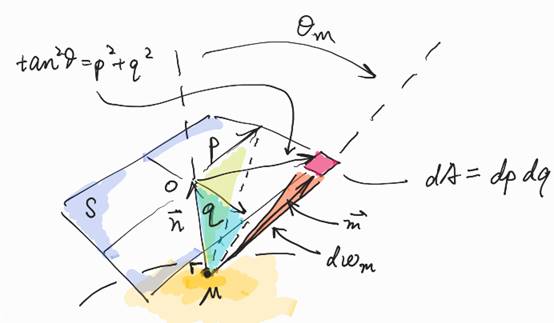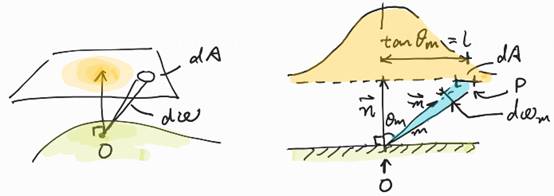Notes for GGX paper
Here are some notes for the GGX paper "Microfacet Models for Refraction through Rough Surfaces". In this article, I will give derivations for some important equation in this paper.
Derivation for equation (8)
This equation tell us how to construct a macrosurface BRDF given microsurface 's D, G, F.
![]()
In this equation,
![]() is
incident vector.
is
incident vector.
![]() is
outgoing vector.
is
outgoing vector.
![]() is
macrosurface normal.
is
macrosurface normal.
![]() is
microsurface normal.
is
microsurface normal.
![]() is
the macrosurface BRDF.
is
the macrosurface BRDF.
![]() is
the microsurface BRDF.
is
the microsurface BRDF.
![]() is
microfacet distribution function.
is
microfacet distribution function.
![]() is
shadowing-masking function.
is
shadowing-masking function.
![]() is
solid angle in the hemisphere
is
solid angle in the hemisphere ![]() .
.
How can we get this equation? Please see the figure below.

In this figure, the surface is illuminated
by a light source and an observer is looking at the surface. The observer has a
microscope so that he will see the microfacets s1, s2,
... . These microfacets have different colors because of their orientations are
different. When the observer look at the surface at the same location, but
without the microscope, he will no longer see the microfacets but a uniform color.
This time, he knows that it is colors from microfacets that mix together and
form the uniform color. Let's denote the colors from microfacets as ![]() and
the uniform color as
and
the uniform color as ![]() .
Then we have:
.
Then we have:
![]()
In this equation,
![]() is
the projected area of si . According to the definition of microfacet
distribution function, we have:
is
the projected area of si . According to the definition of microfacet
distribution function, we have:
![]()
In this equation,
![]() is
the area of macrosurface.
is
the area of macrosurface.
![]() is i-th microfacet's normal.
is i-th microfacet's normal.
![]() is
a small solid angle aligned with
is
a small solid angle aligned with ![]() .
.
![]() is
microfacet distribution function.
is
microfacet distribution function.
Combine these equations, we have:
![]()
We can
eliminate ![]() and using the equation
(3) in the paper:
and using the equation
(3) in the paper:
![]()
Convert sum to integral, then we get:
![]()
Now we
can see the term ![]() .
Let's investigate the term
.
Let's investigate the term![]() further:
further:
![]()
In this equation,
![]() is
a small solid angle of incident light over the hemisphere
is
a small solid angle of incident light over the hemisphere ![]() .
.
Finally, we have:

According to the rendering equation
![]()
We can
regard the inner integral ![]() as
the equivalent BRDF for macrosurface, so that we get:
as
the equivalent BRDF for macrosurface, so that we get:
![]()
Confirm equation (9)
According to the definition of radiance:
![]()
In this equation,
![]() is
the radiance in outgoing direction
is
the radiance in outgoing direction ![]()
![]() is
luminous flux
is
luminous flux
![]() is area of
macrofacet
is area of
macrofacet
So the outgoing irradiance is:
![]()
Put equation (9) in, we have:
![]()
According to equation (10),

So According to equation (9), the overall
outgoing irradiance equals the incoming irradiance scaled by a factor ![]() ,
which is less than 1.
,
which is less than 1.
Derivation for equation (20)
According to equation (8),
![]()
Put equation (15) in it, we have:
![]()
When ![]() ,
,
![]() ,
then according to equation (10), we have:
,
then according to equation (10), we have:
![]()
Derivation for equation (42)
Let us take a careful look at the
definition of ![]() .
.
Suppose there is one point ![]() on
surface whose normal is
on
surface whose normal is ![]() ,
we construct a plane
,
we construct a plane![]() perpendicular
to the normal and choose two perpendicular axes
perpendicular
to the normal and choose two perpendicular axes ![]() and
and
![]() .
For a small patch
.
For a small patch ![]() on the plane,
we denote the direction pointing from
on the plane,
we denote the direction pointing from ![]() to
it
to
it ![]() ,
and the small solid angle it occupies
,
and the small solid angle it occupies ![]() .
.

According to equation (4), which is
![]()
We can consider ![]() as the probability density
as the probability density ![]() of
finding a microfacet whose normal
of
finding a microfacet whose normal ![]() is
inside
is
inside ![]() ,
so that we have
,
so that we have

That's exactly what ![]() is.
is.
Derivation for equation (45)
Break the ray into many short segments,
each with projected length ![]() .
According to the paper, the probability that the ray is first blocked in
segment
.
According to the paper, the probability that the ray is first blocked in
segment ![]() is
is
![]() , so the probability that ray is always unblocked is:
, so the probability that ray is always unblocked is:

Then we have:

From calculus we know:
![]()
So

So that
![]()
Derivation for equation (46)
Let's consider the situation that a ray
intersects with an short and straight surface segment ![]() .
In order to do that, the surface height should below the ray at
.
In order to do that, the surface height should below the ray at ![]() and
above the ray at
and
above the ray at ![]() . For a given slope
. For a given slope ![]() ,
there exist a set of surface segments that fulfill this condition, which are in
the shaded areas in the figures below.
,
there exist a set of surface segments that fulfill this condition, which are in
the shaded areas in the figures below.

It's easy to note that the possible surface
height at ![]() varies from
varies from ![]() to
to
![]() .
So given a surface with slope
.
So given a surface with slope ![]() ,
the probability that it intersects with a ray
,
the probability that it intersects with a ray ![]() is
is
![]()
In this equation,
![]() is
the probability density that surface height reaches
is
the probability density that surface height reaches ![]() at
point
at
point ![]() .
.
Also we know that the probability that a
surface segment has slope ![]() is
is
![]()
Combine them, then we get the probability
for finding a surface segment with slope ![]() as
well as intersecting with the ray:
as
well as intersecting with the ray:
![]()
Consider all possible surface slope ![]() ,
the probability that they intersect with the ray is:
,
the probability that they intersect with the ray is:
![]()
Among all surface segments with slope ![]() ,
the probability that a surface segment below the ray is:
,
the probability that a surface segment below the ray is:
![]()
Consider all possible surface slope ![]() ,
the probability that they below the ray is:
,
the probability that they below the ray is:
![]()
Assume ![]() is
independent from
is
independent from ![]() ,
we have:
,
we have:
![]()
So the probability that a ray first
intersects with surface in ![]() is:
is:

Let ![]() ,
so
,
so

Derivation for equation (49)
From equation (48), we have:

Note that
![]()
So
![]()
Then

![]()
![]()
Put it in equation (45):

Derivation for equation (50)

Explanation of Beckmann Distribution Model
The distribution function of Beckmann Model is:

Let’s see the meaning of Beckmann
Distribution Model. I use the way when I derive equation (42). That is, make a
plane perpendicular to the surface normal, and make sure the distance between
the plane and surface point O is 1. For a microfacet normal ![]() ,
it must be pointing at a point P on the plane. So we can transform the
probability density of
,
it must be pointing at a point P on the plane. So we can transform the
probability density of ![]() to
another density function on the plane. I will show that it is a Gaussian
function.
to
another density function on the plane. I will show that it is a Gaussian
function.

According to equation (4), which is
![]()
We can consider ![]() as the probability density of finding
a microfacet whose normal
as the probability density of finding
a microfacet whose normal ![]() is
inside
is
inside ![]() .
Also, we know:
.
Also, we know:
![]()
In this equation, ![]() is
the distance between projected point P and surface point O.
is
the distance between projected point P and surface point O.
So the probability of finding a microfacet
whose normal ![]() is
inside
is
inside ![]() is:
is:

Look! It’s a gaussian distribution function
with variation ![]() .
That’s what Beckmann Distribution really is.
.
That’s what Beckmann Distribution really is.
G1 for Beckmann Distribution
According to equation (51),
![]()
where
![]()
For Beckmann Distribution,

Also we know ![]() ,
so
,
so

From normal distribution we know:
![]()
So

The first integration is:

The second one is:

Put ![]() and
and
![]() in
it, we have:
in
it, we have:

Finally,

Explanation of Phong Distribution Model
The distribution function of Phong model is:
![]()
The same as Beckmann model, we try to
project ![]() to
a plane above the surface point P, that is
to
a plane above the surface point P, that is

We can confirm that the overall probability is

附件列表



